Attached files
| file | filename |
|---|---|
| 8-K - HOLLY ENERGY PARTNERS LP | form8-kxheppresentation.htm |

Holly Energy Partners, L.P. Retail Investor Conferences.com Virtual Investor Presentation April 2012

Safe Harbor Disclosure Statement 2 Statements made during the course of this presentation that are not historical facts are “forward-looking statements” within the meaning of the U.S. Private Securities Litigation Reform Act of 1995. Forward- looking statements are inherently uncertain and necessarily involve risks that may affect the business prospects and performance of Holly Energy Partners L.P. and/or HollyFrontier Corporation. Actual results may differ materially from those discussed during this presentation. Such risks and uncertainties include, but are not limited to, actions of actual or potential competitive suppliers and transporters of refined petroleum products in Holly Energy Partners’ and HollyFrontier’s markets, the demand for and supply of crude oil and refined products, the spread between market prices for refined products and market prices for crude oil, the possibility of constraints on the transportation of refined products, the possibility of inefficiencies or shutdowns in refinery operations or pipelines, effects of governmental regulations and policies, the availability and cost of financing to Holly Energy Partners and HollyFrontier, the effectiveness of Holly Energy Partners’ and HollyFrontier’s capital investments, marketing and acquisition strategies, the possibility of terrorist attacks and the consequences of any such attacks, and general economic conditions. Additional information on risks and uncertainties that could affect the business prospects and performance of Holly Energy Partners and HollyFrontier are provided in the most recent reports of Holly Energy Partners and HollyFrontier filed with the Securities and Exchange Commission. All forward-looking statements included in this presentation are expressly qualified in their entirety by the foregoing cautionary statements. Holly Energy Partners and HollyFrontier undertake no obligation to publicly update or revise any forward-looking statements, whether as a result of new information, future events or otherwise.

Holly Energy Partners Investment Highlights 100% Fee Based Business All revenues derived from: tariffs from pipeline movements; storage & transfer fees for terminal activity; loading fees for loading rack activity & capacity lease commitments. Long Term Contracts Supporting Revenue Stream Major customers have entered into 15-year long term contracts with minimum contracted obligations for volume and/or revenues. Proven Record of Distribution Increases Increased distribution every quarter since IPO in 2004. 29 consecutive quarters from IPO thru February 2012. Assets Serving High Growth Markets Southwest & Rocky Mountain footprint historically high growth markets attracting business & population. Growth From Holly’s Refining Growth Plan As HollyFrontier continues to prudently expand refining asset base, HEP generally has right of first refusal on all logistic assets HollyFrontier builds or acquires. 3
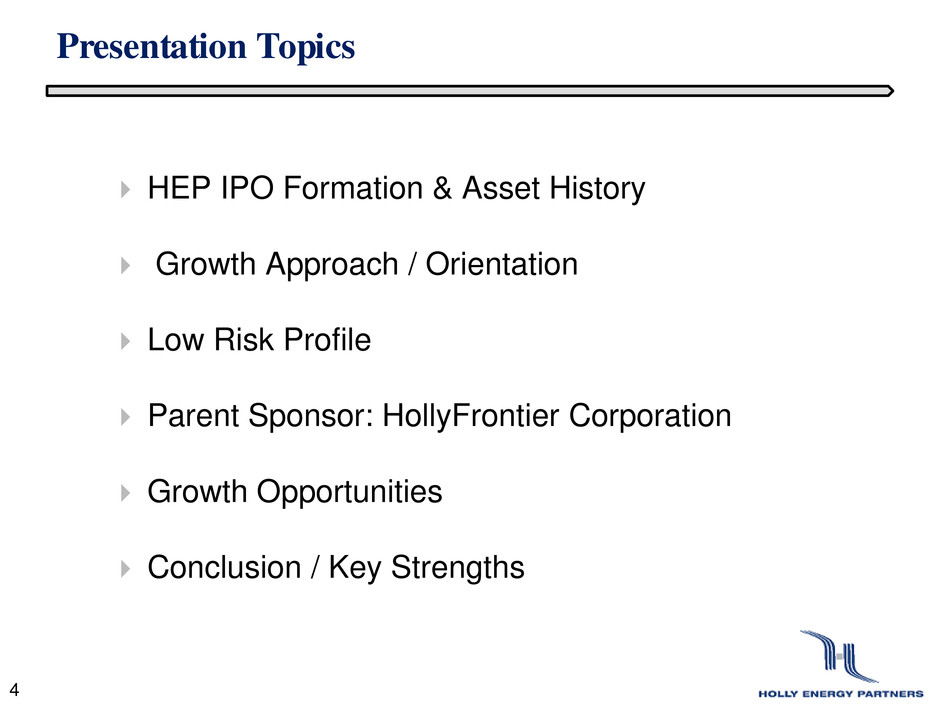
Presentation Topics HEP IPO Formation & Asset History Growth Approach / Orientation Low Risk Profile Parent Sponsor: HollyFrontier Corporation Growth Opportunities Conclusion / Key Strengths 4

HEP Formation 2004: IPO Detail 5 HEP formed in 2004 and taken public in an Initial Public Offering sponsored by Holly Corporation (now HollyFrontier Corporation NYSE:HFC) • 49% of common units sold to public holders • HFC retained 49% ownership of common units • HFC became 2% General Partner owner

HEP Formation 2004: Rationale 6 • Parent sponsor had significant logistic assets (pipelines, terminals & loading rack facilities) to support its Southwest U.S. refining business • Parent also knew the value of this business would not be fully recognized & appreciated by Wall Street investors as it played only a support role & was not a separate standalone business • Refining business tends to be cyclical & volatile • Logistics businesses (pipelines & terminals) tend to be more steady & stable • The logistics business would likely command a higher valuation by Wall Street investors if separated from the volatile refining business • HEP IPO’d in July 2004 to achieve better value recognition & create a more efficient holding entity for these logistics assets

HEP Formation 2004: Assets & Business 7 Assets / Business at IPO: • Approximately 1,000 miles of refined product pipelines in the Southwest U.S. • 9 product terminals with approximately 2 million barrels of storage in 5 Western & Rocky Mountain states • 2 refined product truck rack loading facilities • 70% JV owner (w/ B-P) of Rio Grande Pipeline , moving LPG’s from West Texas into Mexico • EBITDA (Pre-tax cash flow) at IPO was approximately $35 million annually • Distribution paid to unitholders at IPO was $2/unit annually (approximate 9% yield)

Growth 8

9 2004 2005 2006 2007 2008 2009 MLP IPO (Jul 2004) Holly intermediate feedstock pipeline acquisition (Jul 2005) 25% JV with Plains for SLC pipeline (Mar 2009) Holly Tulsa loading rack dropdown acquisition (Tulsa West) (Aug 2009) Holly crude oil and tankage assets acquisition (Mar 2008) Alon pipeline and terminal asset acquisition (Feb 2005) Holly 16" Intermediate pipeline facilities acquisition (Jun 2009) Sinclair Tulsa (Tulsa East) & Roadrunner/ Beeson acquisitions (Dec 2009) Sale of 70% interest in Rio Grande to Enterprise (Dec 2009) 2010 Purchase of additional Tulsa tanks and racks; Lovington rack (March 2010) 2011 HFC Dropdown of El Dorado & Cheyenne assets (Nov 2011) Holly South line expansion project (2007-08) HEP Growth Chronology: IPO to Present

IPO July 2004 Pipeline miles 1,000 2,400 Product terminals 9 11 Truck racks 2 8 Storage (mm bbls) 2.0 11.6 Annual EBITDA run-rate ($mm) $35.0 $180.0 Quarterly distr ($/unit/qtr)* $0.500 $0.885 Unit price ($/unit) $22.25 $61.00 LP unit yield 9.0% 5.8% LP units outstanding (mm) 14.0 27.4 Market capitalization ($mm) $311.5 $1,671.4 Current Holly Energy Partners Assets: Then & Now 10

HEP Assets: Current Footprint -- Description • Over 2,400 miles of product & crude oil pipelines • Over 11 million bbls of refined product and crude oil storage • 24 terminals & loading rack facilities in 8 Western and Mid-continent states • 25% Joint Venture interest SLC Pipeline, LLC—a crude oil pipeline moving crude into the Salt Lake City area 11 • Revenues have grown to approximately $250 million • EBITDA at approx. $180 million annually • Distribution paid to unitholders in 2011 was $3.44/unit

HFC and HEP Assets: Current Footprint -- Map 12

U.S. Population Growth By State (2000 – 2010) Traditionally High Growth, Niche Markets • States served by HEP are among the fastest growing in the country • UNEV project to provide greater access to Nevada and southern Utah markets RI DC Loss 0-5% 5-15% 15-25% 25% + NH VT MA CT NJ DE MD PR Legend Area Served by HEP Source: U.S. Census Bureau. Reflects 2010 Census Results. 13

HEP Growth: EBITDA Since Inception (steady state run rate*) 14 $0 $25 $50 $75 $100 $125 $150 $175 $200 $35 $17 $10 $5 $20 $3 $10 $6 $3 $3 $12 $12 $40 $5 $180 $ in mi llio ns *Definition on page 32

15 HEP Growth: Distributable Cash Flow* $20 $40 $60 $80 $100 $120 2005 2006 2007 2008 2009 2010 2011 $41.4 $47.2 $51.0 $60.4 $72.2 $91.0 $100.3 Di stribu tab le Ca sh Flow (mm’ s) *Definition on page 32

16 HEP Growth: Limited Partner Distributions $2.00 $2.25 $2.50 $2.75 $3.00 $3.25 $3.50 2005 2006 2007 2008 2009 2010 2011 $2.22 $2.58 $2.78 $2.96 $3.12 $3.28 $3.44 Annual Distribution ($/unit) Distribution has been increased every quarter since IPO—29 consecutive quarters Current distribution (Q1 2012) annual run rate: $3.541 1Feb 2012 quarterly rate of $0.885/unit times 4 quarters equals $3.54

Low Risk Profile / Orientation 17

Stable Cash Flows Revenue Stability: • Minimum commitments paid by major shippers • (even if shipments do not occur) • Long term (15-year) contracts in place with major customers • Over 80% of revenues tied to long term contracts and minimum commitments 18
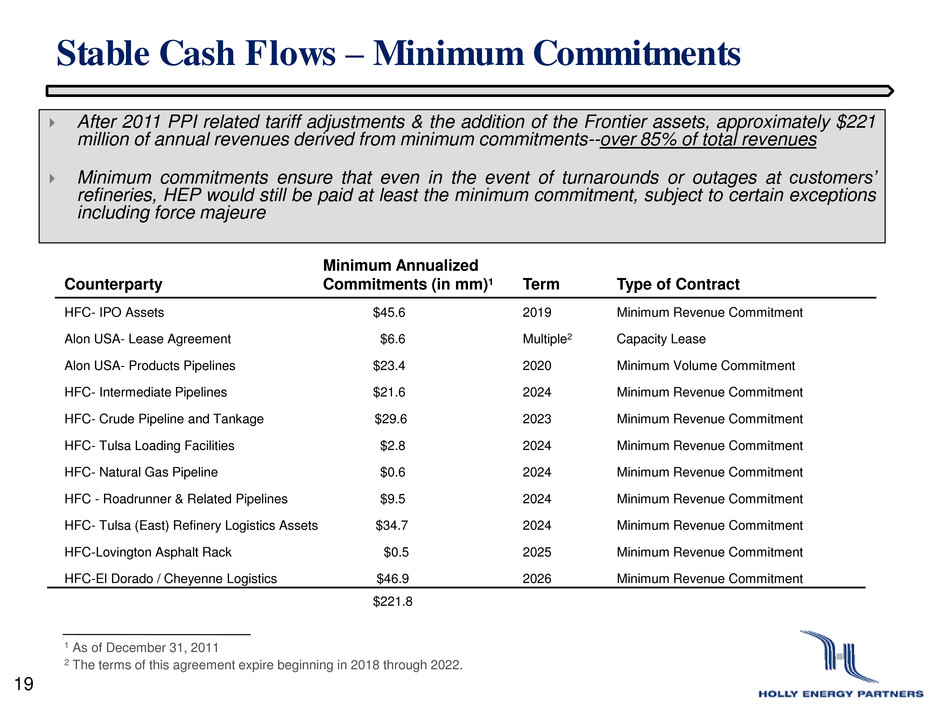
Stable Cash Flows – Minimum Commitments After 2011 PPI related tariff adjustments & the addition of the Frontier assets, approximately $221 million of annual revenues derived from minimum commitments--over 85% of total revenues Minimum commitments ensure that even in the event of turnarounds or outages at customers’ refineries, HEP would still be paid at least the minimum commitment, subject to certain exceptions including force majeure 1 As of December 31, 2011 2 The terms of this agreement expire beginning in 2018 through 2022. 19 Minimum Annualized Counterparty Commitments (in mm)¹ Term Type of Contract HFC- IPO Assets $45.6 2019 Minimum Revenue Commitment Alon USA- Lease Agreement $6.6 Multiple2 Capacity Lease Alon USA- Products Pipelines $23.4 2020 Minimum Volume Commitment HFC- Intermediate Pipelines $21.6 2024 Minimum Revenue Commitment HFC- Crude Pipeline and Tankage $29.6 2023 Minimum Revenue Commitment HFC- Tulsa Loading Facilities $2.8 2024 Minimum Revenue Commitment HFC- Natural Gas Pipeline $0.6 2024 Minimum Revenue Commitment HFC - Roadrunner & Related Pipelines $9.5 2024 Minimum Revenue Commitment HFC- Tulsa (East) Refinery Logistics Assets $34.7 2024 Minimum Revenue Commitment HFC-Lovington Asphalt Rack $0.5 2025 Minimum Revenue Commitment HFC-El Dorado / Cheyenne Logistics $46.9 2026 Minimum Revenue Commitment $221.8

No Commodity Risk No Commodity Risk: 100% fee based revenue stream HEP owns no inventory—no inventory price risk No commodity ownership risk or hedging necessary 20

Relationship w/ Parent Sponsor--HollyFrontier 21
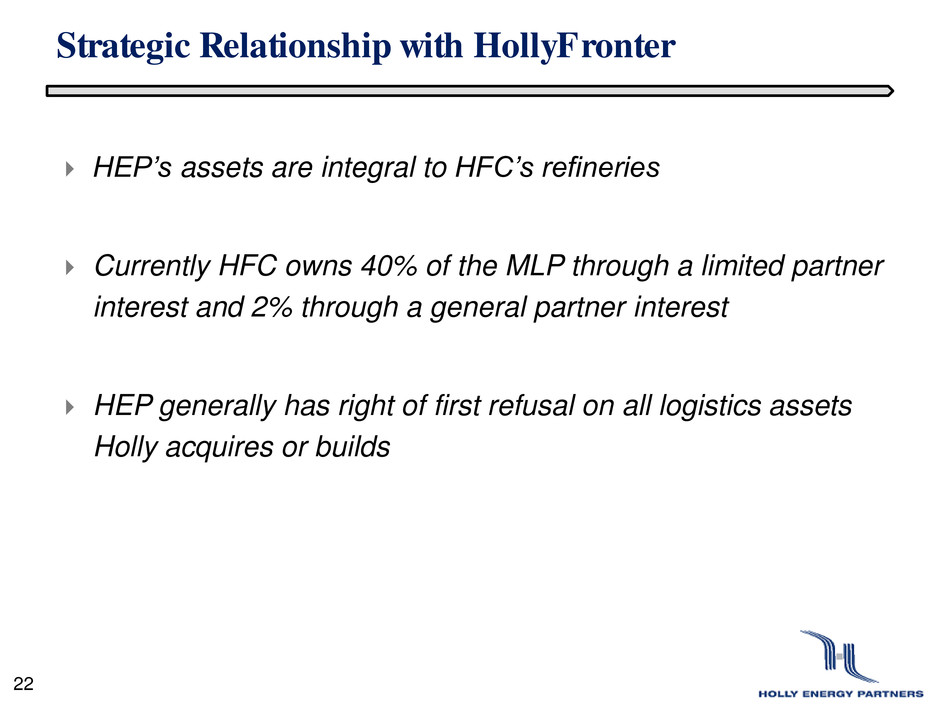
Strategic Relationship with HollyFronter HEP’s assets are integral to HFC’s refineries Currently HFC owns 40% of the MLP through a limited partner interest and 2% through a general partner interest HEP generally has right of first refusal on all logistics assets Holly acquires or builds 22
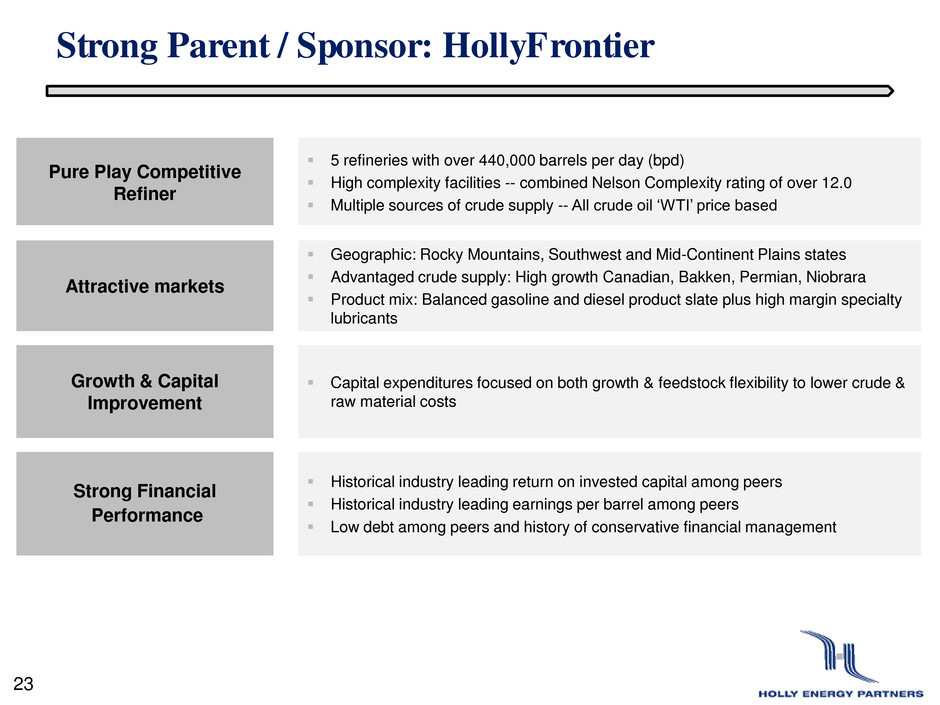
23 Pure Play Competitive Refiner 5 refineries with over 440,000 barrels per day (bpd) High complexity facilities -- combined Nelson Complexity rating of over 12.0 Multiple sources of crude supply -- All crude oil ‘WTI’ price based Attractive markets Geographic: Rocky Mountains, Southwest and Mid-Continent Plains states Advantaged crude supply: High growth Canadian, Bakken, Permian, Niobrara Product mix: Balanced gasoline and diesel product slate plus high margin specialty lubricants Growth & Capital Improvement Capital expenditures focused on both growth & feedstock flexibility to lower crude & raw material costs Strong Financial Performance Historical industry leading return on invested capital among peers Historical industry leading earnings per barrel among peers Low debt among peers and history of conservative financial management Strong Parent / Sponsor: HollyFrontier
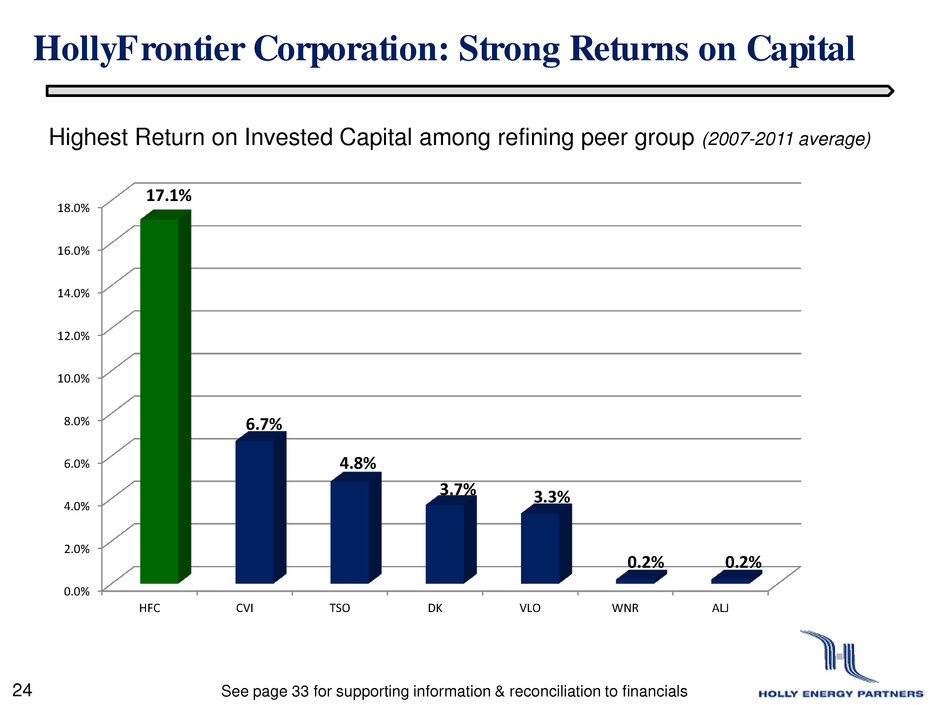
0.0% 2.0% 4.0% 6.0% 8.0% 10.0% 12.0% 14.0% 16.0% 18.0% HFC CVI TSO DK VLO WNR ALJ 17.1% 6.7% 4.8% 3.7% 3.3% 0.2% 0.2% HollyFrontier Corporation: Strong Returns on Capital 24 Highest Return on Invested Capital among refining peer group (2007-2011 average) 3 4 See page 33 for supporting information & reconciliation to financials
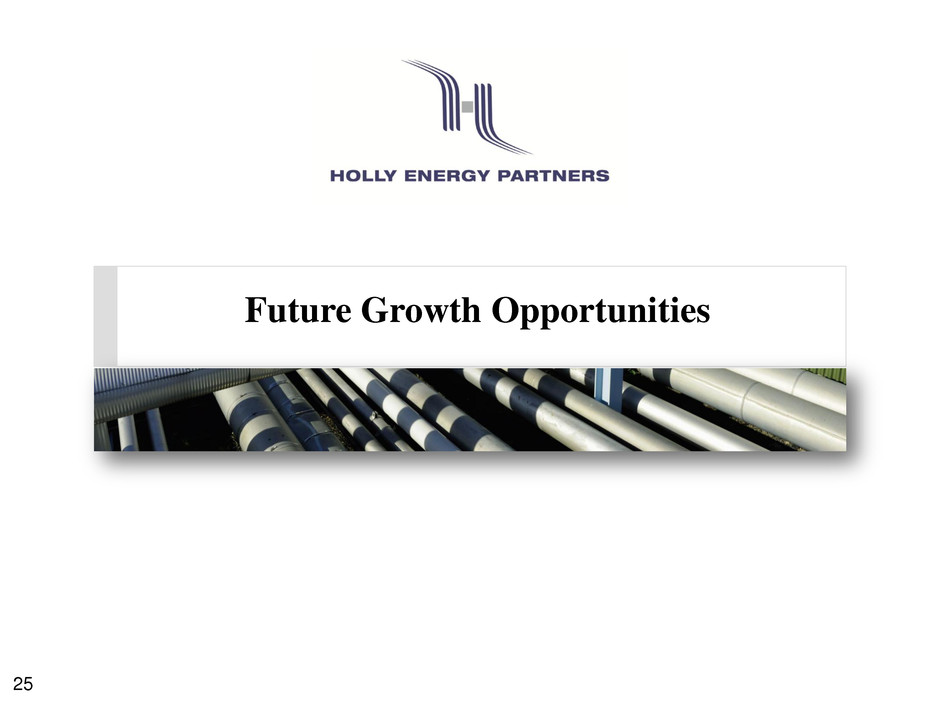
Future Growth Opportunities 25

Growth Opportunity: UNEV Pipeline– 2012 Description: ■ HFC owns a 75% interest in 400 mile refined products pipeline from Salt Lake City to Las Vegas with terminals in Cedar City, UT, and Las Vegas, NV ■ HFC funded through construction ■ HEP has option to purchase HFC ownership interest ■ Sinclair owns remaining 25% interest Benefits: ■ Opens refined product supply to sizable market with consistent annual demand ■ Lowers seasonal impact to SLC refiners because of demand reduction in wintertime months in local market ■ New outlet for other crude-cost-advantaged Rocky Mountain refiners Capacity: ■ 62,000 bpd* (expandable to 118,000 bpd) Completion Date: ■ Completed 2011 – Line operational, January 2012 26 * for gasoline equivalent shipments

Growth Opportunity: Permian Basin Crude Oil Infrastructure Description: ■ Building / reactivating crude oil pipelines in Permian to transport crude oil in the rapidly developing Bone Springs production area Benefits: ■ Transport additional volumes of crude oil to HFC or into crude oil mainlines to deliver to Permian Basin crude oil market centers Capacity: ■ 60,000 BPD (initial capacity) Estimated EBITDA: ■ $10-20 million Completion Date: ■ Completion expected 3Q 2012 27

Conclusion / Key Strengths 28

Holly Energy Partners Investment Highlights 100% Fee Based Business All revenues derived from: tariffs from pipeline movements; storage & transfer fees for terminal activity; loading fees for loading rack activity & capacity lease commitments. Long Term Contracts Supporting Revenue Stream Major customers have entered into 15-year long term contracts with minimum contracted obligations for volume and/or revenues. Proven Record of Distribution Increases Increased distribution every quarter since going public. 29 consecutive quarters from IPO thru February 2012. Assets Serving High Growth Markets Southwest & Rocky Mountain footprint have historically been high growth markets attracting business & population. Growth From Holly’s Refining Growth Plan HollyFrontier continues to prudently expand its refining asset base. HEP generally has right of first refusal on all logistic assets HollyFrontier builds or acquires. 29

Contact Information: 30 Holly Energy Partners, L.P. (NYSE: HEP) 2828 N. Harwood, Suite 1300 Dallas, Texas 75201 (214) 871-3555 For investor relations questions please contact: Neale Hickerson, Vice President-Investor Relations neale.hickerson@hollyenergy.com Julia Heidenreich, Investor Relations julia.heidenreich@hollyenergy.com

31 Appendix

Definitions 32 BPD: Barrels per day DISTRIBUTABLE CASH FLOW: Distributable cash flow (DCF) is not a calculation based upon GAAP. However, the amounts included in the calculation are derived from amounts separately presented in our consolidated financial statements, with the exception of excess cash flows over earnings of SLC Pipeline, maintenance capital expenditures and distributable cash flow from discontinued operations. Distributable cash flow should not be considered in isolation or as an alternative to net income or operating income as an indication of our operating performance or as an alternative to operating cash flow as a measure of liquidity. Distributable cash flow is not necessarily comparable to similarly titled measures of other companies. Distributable cash flow is presented here because it is a widely accepted financial indicator used by investors to compare partnership performance. We believe that this measure provides investors an enhanced perspective of the operating performance of our assets and the cash our business is generating. Our historical distributable cash flow is reconciled to net income in footnote 5 to the table in "Item 6. Selected Financial Data" of HEP's 2011 10-K. EBITDA: Earnings before interest, taxes, depreciation and amortization which is calculated as net income plus (i) interest expense net of interest income and (ii) depreciation and amortization. EBITDA is not a calculation based upon U.S. generally accepted accounting principles (“U.S. GAAP”). However, the amounts included in the EBITDA calculation are derived from amounts included in our consolidated financial statements. EBITDA should not be considered as an alternative to net income or operating income, as an indication of our operating performance or as an alternative to operating cash flow as a measure of liquidity. EBITDA is not necessarily comparable to similarly titled measures of other companies. EBITDA is presented here because it is a widely used financial indicator used by investors and analysts to measure performance. EBITDA is also used by our management for internal analysis and as a basis for compliance with financial covenants. Our historical EBITDA is reconciled to net income in footnote 4 to the table in “Item 6. Selected Financial Data” of HEP’s 2011 10-K. STEADY STATE EBITDA: EBITDA as defined above calculated on the basis of our projection of normal pipeline and terminal volumes from our customers, applicable tariffs and fees, and normal expense levels, and assuming no material unplanned shutdowns or unavailable capacity.

Financial metrics for HFC (page 23)* * Holly debt excludes HEP debt; All amounts are based on publicly-available financial statements, which we have assumed to be accurate. 33 HOLLYFRONTIER 2011 2010 2009 2008 2007 5-Yr Ave ROIC Net Income $ 1,330.2 $ 141.6 $ (65.0) $ 347.0 $ 736.1 Total Debt EX HEP $ 1,036.8 $ 674.8 $ 725.8 $ 5.2 $ 150.0 Total Equity $ 7,098.1 $ 2,274.6 $ 2,151.6 $ 1,587.4 $ 1,474.3 ROIC 16% 5% -2% 22% 45% 17.2% Company 2011 ROIC 2010 ROIC 2009 ROIC 2008 ROIC 2007 ROIC 5 Yr. Ave ROIC CVI 18.7% 1.0% 6.0% 15.0% -7.0% 6.7% VLO 8.7% 1.0% -9.0% -5.0% 21.0% 3.3% DK 15.5% -11.0% 0.0% 3.0% 11.0% 3.7% ALJ 2.9% -10.0% -8.0% 5.0% 11.0% 0.2% WNR 8.2% -1.0% -19.0% 3.0% 10.0% 0.2% HFC 16.0% 4.8% -2.3% 21.8% 45.3% 17.1% TSO 10.0% -1.0% -3.0% 6.0% 12.0% 4.8%
